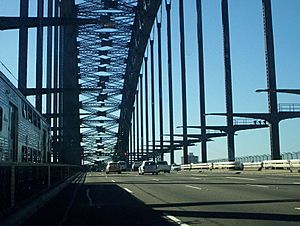Transport in New South Wales facts for kids
New South Wales (NSW) in Australia has a huge and varied transport system. It helps people and goods move around the state. This system includes roads, trains, buses, ferries, taxis, and even planes. The main group in charge of making sure it all works is called Transport for NSW. They plan, build, and manage how people travel.
Roads in NSW
Transport for NSW is the main government group in charge of roads in NSW. They look after big roads, like highways. They also help local councils pay for smaller roads in towns and regions. With help from the Australian Government, they also manage the national highways in NSW.
The team at Transport for NSW manages a lot of roads. They look after 4,787 bridges across the state. They also manage over 17,623 kilometers of state roads and highways. This includes 3,105 kilometers of national highways.
Trains and Railways
For a long time, trains in NSW were run by the government. Today, Transport for New South Wales (TfNSW) oversees the railway system. Two main groups run the train services. NSW TrainLink handles longer trips between cities and regions. Sydney Trains runs the trains within the city of Sydney.
The tracks and railway buildings are owned by another group called Transport Asset Holding Entity. Freight trains, which carry goods, are run by private companies like Pacific National. Some important train lines, like those for coal in the Hunter Valley, are managed by the Australian Rail Track Corporation.
Public Transport System
New South Wales has the biggest public transport system in Australia. This means more people use buses, trains, and ferries to get around. A long time ago, in the 1920s, Sydney had the largest tram network in the Southern Hemisphere!
In Sydney, almost twice as many people use public transport to get to work compared to other big cities in Australia. Transport for NSW works to connect all these services. They want to make it easy to travel around Sydney, Newcastle, the Central Coast, the Blue Mountains, Wollongong, and the Illawarra.
Taxis in NSW
New South Wales has a very large taxi system. There are about 6,000 taxis driving around the state. More than 22,000 people work as taxi drivers. This makes it the biggest taxi network in Australia.
Most taxis are common car models like Ford Falcons, Holden Commodores, and Toyota Camrys. Some also use Toyota Prius cars, which are more fuel-efficient. Taxis usually run on a special type of gas called liquid petroleum gas. Most taxis are owned by small businesses. These owners pay a fee to join a radio network. These networks help taxis get bookings by phone or internet.
Air Travel
The main airport in NSW is Sydney Airport. It is a very busy airport for both local and international flights. A new airport, called the Western Sydney Airport, is planned to open in 2026. This will help handle more flights and travelers in the future.
Sea Ports
New South Wales has several important seaports. These are places where ships load and unload goods.
- Port Jackson, located in central Sydney.
- Port Botany, found in Sydney's south.
- Port Kembla, which is south of Wollongong.
- Port of Newcastle, located in Newcastle, north of Sydney.
Smaller regional ports, like those in Eden and Yamba, are also managed by Transport for NSW.


